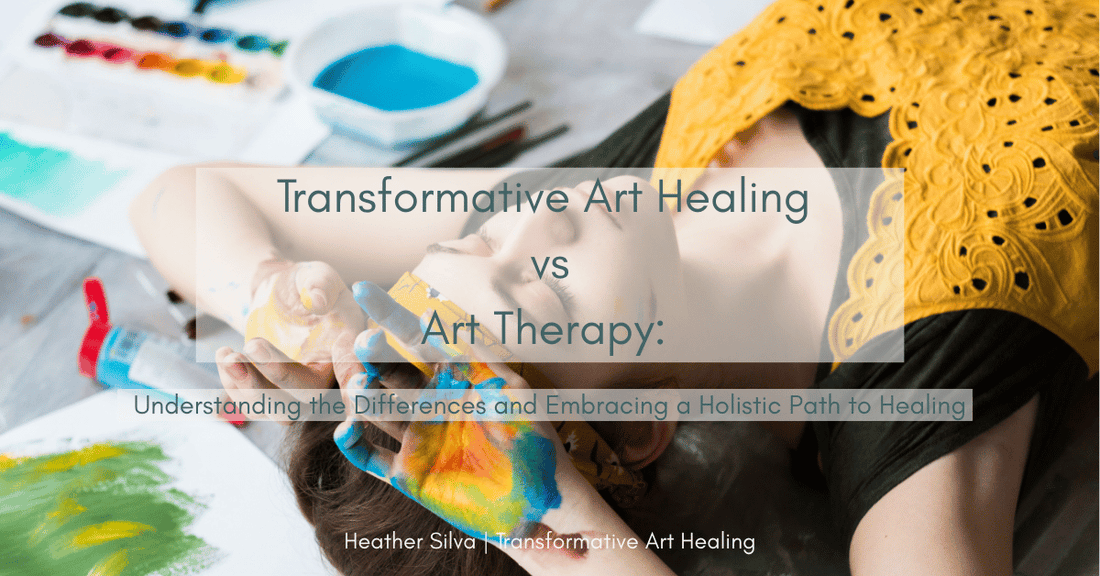
Transformative Art Healing vs. Art Therapy: Understanding the Differences and Embracing a Holistic Path to Healing
Share
In today's fast-paced world, many individuals seek creative avenues to navigate emotional challenges, foster personal growth, and achieve holistic well-being. While art therapy has long been recognized as a valuable tool in mental health treatment, a newer modality—Transformative Art Healing (TAH)—is emerging as a profound approach that transcends traditional therapeutic boundaries. This blog post explores the key differences between these two modalities and elucidates why Transformative Art Healing may offer a more expansive and empowering path to healing.
What Is Art Therapy?
Art therapy is a form of psychotherapy that utilizes creative processes—such as drawing, painting, and sculpting—to help individuals express emotions, improve self-awareness, and address psychological issues. Conducted by credentialed professionals with specialized training in both art and psychology, art therapy is often employed to treat mental health conditions like anxiety, depression, PTSD, and cognitive impairments. American Art Therapy Association
In art therapy sessions, clients engage in art-making under the guidance of a therapist, who helps them explore the symbolic meanings of their creations to gain insights into their emotions and behaviors. This modality is particularly beneficial for individuals who find it challenging to articulate their feelings verbally. Verywell Mind
What Is Transformative Art Healing?
Transformative Art Healing (TAH) is an integrative practice that combines creative expression with spiritual exploration, personal development, and holistic well-being. Unlike traditional art therapy, TAH is not confined to clinical settings or solely focused on treating psychological disorders. Instead, it invites individuals to embark on a journey of self-discovery, empowerment, and transformation through the creative process.
Practitioners of TAH may incorporate various modalities, including meditation, energy work, and intuitive guidance, alongside artistic activities. The emphasis is on accessing inner wisdom, fostering resilience, and facilitating profound personal shifts that extend beyond symptom relief.
Key Differences Between Art Therapy and Transformative Art Healing
| Aspect | Art Therapy | Transformative Art Healing |
|---|---|---|
| Primary Focus | Clinical treatment of mental health issues | Holistic personal growth and spiritual transformation |
| Practitioner Credentials | Licensed therapists with formal training in psychology and art therapy | Diverse backgrounds; may include artists, healers, and spiritual guides |
| Setting | Clinical environments (hospitals, therapy offices) | Varied settings (studios, retreats, community spaces) |
| Approach | Therapist-directed, goal-oriented | Client-centered, exploratory, and intuitive |
| Outcome Goals | Symptom reduction, improved functioning | Empowerment, self-realization, and life transformation |
Why Choose Transformative Art Healing?
While art therapy offers valuable support for individuals dealing with specific psychological challenges, Transformative Art Healing provides a more expansive framework for those seeking deep personal growth and holistic well-being. Here are some reasons why TAH may be the preferred choice:
1. Holistic Integration
TAH addresses the interconnectedness of mind, body, and spirit, facilitating healing on multiple levels. By engaging in creative practices that honor the whole person, individuals can experience more profound and lasting transformations.
2. Empowerment and Self-Agency
Rather than focusing on pathology, TAH emphasizes personal empowerment and the cultivation of inner resources. Participants are encouraged to take an active role in their healing journey, fostering a sense of autonomy and self-efficacy.
3. Accessibility and Flexibility
TAH is accessible to a broader audience, as it does not require a clinical diagnosis or formal therapy sessions. Individuals can engage in transformative art practices in various settings and adapt them to their unique needs and preferences.
4. Spiritual and Intuitive Exploration
For those seeking to explore spiritual dimensions of healing, TAH offers a supportive space to connect with inner wisdom, intuition, and higher consciousness through creative expression.
Conclusion
Both art therapy and Transformative Art Healing harness the power of creativity for healing and growth. However, TAH extends beyond the clinical scope of traditional art therapy, offering a holistic and empowering approach that nurtures the mind, body, and spirit. By embracing Transformative Art Healing, individuals can embark on a profound journey of self-discovery, resilience, and transformation, unlocking their innate potential for healing and wholeness.
Note: This blog post is for informational purposes only and does not constitute medical or therapeutic advice. Individuals seeking mental health support should consult qualified professionals.
